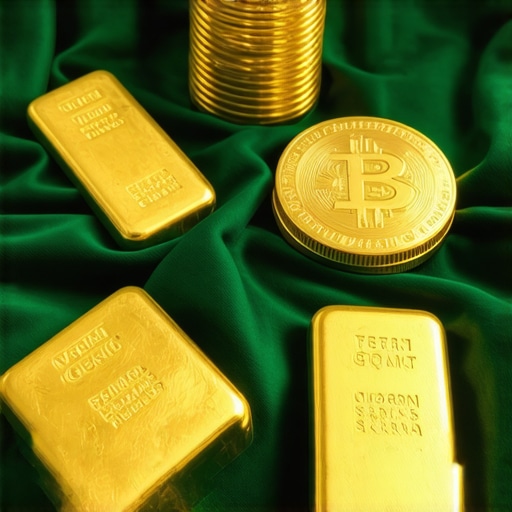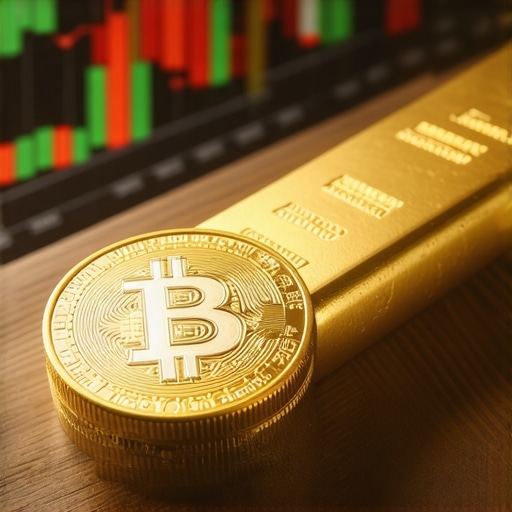Unlocking the Golden Choices: ETFs or Mining Stocks?
Investing in gold often conjures images of physical bars or coins, but modern investors have a richer palette of options. Among these, Gold Exchange-Traded Funds (ETFs) and gold mining stocks stand out as popular vehicles. Yet, the question remains: which aligns best with your portfolio’s goals and risk appetite? This article dives deep into the nuances, helping you navigate these glittering choices with expert clarity.
Gold ETFs: The Simplified Gateway to Precious Metal Exposure
Gold ETFs represent shares in funds that track the price of physical gold, offering investors direct exposure without the hassles of storage or insurance. Their liquidity and transparency make them a favorite for those seeking to hedge against inflation or currency volatility. By owning an ETF, you essentially hold a claim on gold bullion, typically stored securely in vaults. This structure minimizes operational risks and allows for easy entry and exit in the market.
Why do investors often prefer Gold ETFs over mining stocks?
Several factors underpin this preference. First, ETFs closely mirror the spot price of gold, providing a straightforward hedge against market uncertainty. Unlike mining stocks, ETFs are insulated from operational risks such as mine closures, labor strikes, or fluctuating production costs. Additionally, ETFs usually have lower volatility, appealing to risk-averse investors. Their cost structures, while including management fees, often remain more predictable compared to the earnings variability of mining firms.
Gold Mining Stocks: Harnessing Growth Potential Amid Volatility
Gold mining stocks represent ownership in companies engaged in gold extraction and production. Unlike ETFs, their performance is influenced not only by gold prices but also by company-specific factors such as management efficiency, exploration success, and geopolitical risks. This dual exposure can amplify returns during bullish gold markets but also intensify losses when operational challenges arise.
Experienced investors often leverage mining stocks for their potential to outperform physical gold during price upswings. For example, a strategically mined deposit discovery can significantly boost a company’s valuation, offering capital gains that ETFs cannot match. However, mining stocks demand thorough due diligence and active portfolio management, as they are more susceptible to market sentiment and sector-specific risks.
Integrating Gold ETFs and Mining Stocks: Crafting a Balanced Portfolio
Astute investors frequently combine both assets to balance stability with growth. Gold ETFs provide a reliable foundation, preserving wealth and offering liquidity, while selective mining stocks introduce an element of capital appreciation. This blend can enhance diversification, cushioning against sector volatility while capitalizing on bullish cycles.
For those new to gold investing, starting with ETFs might be prudent, gradually layering mining stocks as familiarity and confidence grow. Such an approach aligns with risk tolerance and investment horizon, ensuring the portfolio remains resilient amid market fluctuations.
How Do Market Dynamics Influence Gold ETFs and Mining Stocks Differently?
The price of gold itself is driven by global economic factors including inflation rates, currency strength, and geopolitical tensions. While Gold ETFs track these price movements directly, mining stocks respond to a more complex interplay involving operational costs, regulatory changes, and company earnings alongside gold price trends. For instance, a surge in gold prices can boost mining profits, but rising fuel costs or labor disputes may offset these gains. Understanding these nuances is critical for investors aiming to optimize returns and mitigate risks.
For a deep dive into gold market trends and how supply-demand dynamics shape prices, this authoritative analysis offers valuable insights grounded in current market data.
Curious about tailoring your gold investment strategy? Share your experiences or questions below, and join the conversation on building a resilient portfolio!
My Journey with Gold ETFs and Why They Became a Staple
Reflecting on my own investment journey, I found Gold ETFs to be a comforting entry point into the precious metals arena. Their straightforward nature and liquidity made them ideal for me as a cautious investor. I remember the first time I bought shares of a gold ETF; it felt like owning a piece of stability amid market chaos. The ease of trading and the transparency in pricing gave me confidence, especially during times when global economic news seemed overwhelming.
When Mining Stocks Became More Than Just a Gamble
Venturing into gold mining stocks introduced an entirely different flavor to my portfolio. Initially, I was drawn by stories of mining companies striking new deposits and seeing their stock prices soar. But with time, I learned that success wasn’t just about gold prices rising. Operational challenges and geopolitical factors played huge roles. One mining stock I invested in faced significant setbacks due to labor disputes, teaching me firsthand the importance of thorough research and risk assessment.
How Can You Balance the Allure of Growth with the Desire for Safety in Gold Investments?
This question often comes up when I discuss gold investing with friends and fellow enthusiasts. From my experience, the key lies in understanding your personal risk tolerance and investment horizon. For those seeking steady protection against inflation, gold ETFs provide a reliable cushion. If you’re comfortable with a bit more volatility and have the time to monitor the market closely, mining stocks can offer exciting growth opportunities. Combining both, as I did, helps create a diversified portfolio that can weather various market conditions.
Interestingly, research from the World Gold Council highlights that central bank purchases and global demand trends significantly affect gold prices, which in turn influence both ETFs and mining stocks differently. This underscores the importance of staying informed about macroeconomic factors and how they ripple through the gold market ecosystem.
For those interested in deepening their understanding, exploring how to analyze gold demand trends has been incredibly insightful for me in making smarter investment decisions.
Have you experimented with gold ETFs or mining stocks? What has your experience taught you? Feel free to share your stories or questions in the comments below — I’d love to hear and learn from your journey!
Decoding the Impact of Geopolitical Shifts on Gold Investment Vehicles
The intricate dance between geopolitical events and gold prices often leaves investors pondering how these shifts uniquely influence Gold ETFs and mining stocks. While ETFs generally react almost instantaneously to geopolitical tensions due to their direct linkage to gold prices, mining stocks embody a more layered response. Operational disruptions, regulatory changes, and country-specific risks compound the volatility of mining equities beyond mere price fluctuations of gold itself.
For instance, political instability in a mining region can halt production, causing supply interruptions that might paradoxically boost gold prices but erode mining company valuations simultaneously. Investors must therefore dissect geopolitical news through a dual lens—understanding both macroeconomic triggers and company-level ramifications to navigate these waters effectively.
What advanced risk management techniques can investors apply when balancing Gold ETFs and mining stocks?
Advanced investors often employ a multifaceted risk management framework that includes diversification across geographic regions, hedging with options or futures, and dynamic portfolio rebalancing responsive to market signals. One sophisticated approach is volatility targeting, which adjusts exposure to mining stocks during periods of heightened operational risk while maintaining a stable ETF core to preserve capital.
Moreover, integrating alternative data analytics—such as satellite mining activity observation or real-time labor strike reports—can provide early warnings about potential disruptions. This proactive stance enables timely portfolio adjustments, mitigating downside risks without sacrificing upside potential.
According to the World Gold Council’s comprehensive research, combining quantitative models with qualitative geopolitical analysis yields superior risk-adjusted returns in gold investment portfolios.
Harnessing Technological Innovation: The Future of Gold Mining Stocks
Technological advancements are reshaping the gold mining landscape, influencing investment dynamics profoundly. Automation, AI-powered exploration, and sustainable mining practices not only optimize production efficiency but also reduce environmental and social governance (ESG) risks, factors increasingly scrutinized by investors.
Companies embracing cutting-edge tech stand to enhance their cost structures and exploration success rates, potentially translating to superior stock performance. Conversely, laggards risk obsolescence amid tightening regulatory frameworks and shifting investor preferences towards responsible mining.
Understanding these technological trajectories enables investors to identify mining stocks with durable competitive advantages, beyond mere gold price appreciation. This insight is especially crucial as ESG considerations become integral to institutional investment mandates.
Macro-Financial Indicators and Their Subtle Influence on Gold Investment Choices
Beyond the obvious inflationary pressures and currency movements, subtle macro-financial indicators—such as real interest rate trends, central bank balance sheet policies, and cross-asset correlations—exert nuanced impacts on gold ETFs and mining stocks differently. For example, a steepening yield curve might dampen gold’s allure as a safe haven, affecting ETFs more directly, while mining stocks may react variably depending on capital expenditure cycles and debt servicing costs.
Engaging with these indicators requires sophisticated analytical frameworks and access to real-time economic data feeds. Investors who master these tools can anticipate shifts in gold investment performance before they become apparent to the broader market.
Ready to deepen your expertise and refine your gold investment strategy? Explore our advanced guides and join our upcoming webinar series focused on mastering gold market complexities.
Strategic Layering: Navigating the Nuances of Gold ETF and Mining Stock Allocations
Seasoned investors recognize that the interplay between Gold ETFs and mining stocks is far from static. Tactical portfolio construction involves dynamically adjusting allocations in response to evolving market conditions. For instance, during periods of heightened geopolitical uncertainty, increasing ETF exposure can hedge systemic risks while selectively trimming mining equity positions mitigates operational vulnerabilities.
Conversely, in a robust bull market fueled by rising gold prices and technological breakthroughs in mining, amplifying mining stock weightings may capture outsized returns. This calibrated approach demands continuous market intelligence and a rigorous framework for monitoring key indicators such as geopolitical developments, commodity price momentum, and company-specific operational metrics.
How can investors effectively integrate quantitative models with qualitative insights to enhance gold investment decisions?
Integrating quantitative analytics—like volatility forecasting, factor modeling, and scenario simulations—with qualitative assessments such as management quality, ESG compliance, and geopolitical risk evaluation offers a multidimensional perspective. This hybrid methodology facilitates informed decision-making by balancing statistically driven risk estimates with contextual market realities.
Advanced portfolio managers often employ machine learning algorithms to detect non-linear patterns in gold price movements and mining stock performance, enhancing predictive accuracy beyond traditional econometric models. Simultaneously, expert judgment remains indispensable for interpreting macroeconomic shocks or regulatory shifts that data alone may not fully capture.
For a comprehensive exploration of these integrative investment techniques, the World Gold Council’s research hub provides authoritative frameworks and case studies illustrating best practices in blending quantitative and qualitative approaches.
Technological Disruption as a Catalyst for Differentiated Mining Stock Performance
Emerging innovations such as autonomous drilling, AI-driven exploration analytics, and blockchain-enabled supply chain transparency are not only enhancing operational efficiency but also reshaping investor perceptions of mining equities. Early adopters of these technologies exhibit improved cost structures and reduced ESG risks, translating into a potential valuation premium.
Moreover, the integration of real-time data streams—from satellite imagery monitoring to IoT-enabled equipment diagnostics—empowers companies to proactively manage risks and optimize output. Investors attuned to these technological trajectories can identify mining stocks positioned for sustainable competitive advantage, thereby mitigating some traditional volatility associated with this asset class.
Macro-Financial Signals: Decoding Subtle Market Sentiments Impacting Gold Instruments
Beyond headline inflation and interest rate announcements, nuanced indicators like central bank forward guidance, cross-asset correlation shifts, and liquidity conditions profoundly influence gold-related investments. For example, a dovish pivot by major central banks might buoy gold ETFs through lowered opportunity costs, whereas mining stocks could respond more variably based on capital expenditure outlooks and debt servicing capacity.
Mastering these subtleties requires sophisticated analytical tools and access to real-time economic data, enabling investors to anticipate market inflection points ahead of mainstream dissemination. This foresight can inform timely tactical reallocations between ETFs and mining stocks, optimizing risk-adjusted returns.
Ready to elevate your gold investment acumen? Engage with our advanced analytical guides and register for our upcoming webinar series designed to empower you with cutting-edge market insights and portfolio strategies.
Frequently Asked Questions (FAQ)
What are the primary differences between Gold ETFs and gold mining stocks?
Gold ETFs provide direct exposure to the gold price by holding physical gold or gold futures, offering liquidity, transparency, and lower operational risk. In contrast, gold mining stocks represent ownership in companies extracting gold, whose value depends on gold prices and company-specific factors like operational efficiency, geopolitical risks, and management quality, resulting in higher volatility but potential for greater capital appreciation.
How does geopolitical risk affect Gold ETFs compared to mining stocks?
Geopolitical tensions typically cause immediate price movements in Gold ETFs as they track physical gold prices directly. Mining stocks, however, are affected more complexly; instability can disrupt mining operations, regulatory environments, and supply chains, potentially depressing mining stock valuations even if gold prices rise.
Can combining Gold ETFs and mining stocks improve portfolio diversification?
Yes, integrating both assets balances stability and growth. Gold ETFs offer a hedge against inflation and currency risk with lower volatility, while mining stocks provide exposure to company-specific growth opportunities. Together, they enhance diversification, managing sector-specific and operational risks more effectively.
What role does technology play in the future performance of gold mining stocks?
Technological innovations like automation, AI-driven exploration, and ESG-focused sustainable practices improve mining efficiency, reduce costs, and mitigate environmental risks. Companies leading in technology adoption tend to outperform peers, making technological assessment a critical factor in mining stock selection.
How do macro-financial indicators influence gold investment strategies?
Indicators such as real interest rates, central bank policies, yield curve shifts, and cross-asset correlations impact gold demand and cost of capital differently for ETFs and mining stocks. Sophisticated investors use these signals to anticipate market trends, adjust allocations, and optimize risk-adjusted returns.
What advanced risk management techniques can investors use with gold investments?
Techniques include geographic diversification, hedging with derivatives, volatility targeting, dynamic rebalancing, and integrating alternative data analytics for early risk detection. Combining quantitative models with qualitative insights enhances decision-making and helps mitigate downside risks.
Are Gold ETFs suitable for beginner investors?
Absolutely. Gold ETFs offer a straightforward, liquid, and low-maintenance way to gain exposure to gold prices without the complexities of physical ownership or company-specific risks, making them an excellent entry point for newcomers.
How can investors effectively integrate quantitative and qualitative analysis in gold investing?
By combining statistical tools like volatility forecasting and scenario modeling with qualitative assessments such as management quality, ESG compliance, and geopolitical risk evaluation, investors gain a multidimensional perspective that improves prediction accuracy and strategic agility.
What impact do ESG factors have on gold mining stock valuation?
ESG considerations increasingly influence investor preferences and regulatory environments. Mining companies excelling in environmental stewardship, social responsibility, and governance often enjoy lower risk premiums, better access to capital, and valuation premiums compared to laggards.
How should investors adjust their gold holdings during different market cycles?
During geopolitical uncertainty or economic downturns, increasing allocation to Gold ETFs can provide stability. In bullish markets with rising gold prices and technological advances in mining, shifting toward mining stocks may capture enhanced returns. Tactical adjustment based on market intelligence is key.
Trusted External Sources
- World Gold Council (WGC): As a leading authority on gold market research, WGC offers comprehensive insights into gold investment strategies, demand-supply dynamics, and ESG impacts, providing invaluable data for investors.
- U.S. Geological Survey (USGS) Mineral Resources Program: This government agency provides detailed reports on global gold production, reserves, and mining technologies, essential for understanding operational risks and opportunities in mining stocks.
- Bloomberg Terminal: A premier financial data platform delivering real-time market data, macroeconomic indicators, and advanced analytics, enabling sophisticated quantitative and qualitative analysis of gold investments.
- International Council on Mining and Metals (ICMM): Offers authoritative guidance on sustainability and technological innovation in mining, helping investors evaluate ESG risks and advances influencing mining stock valuations.
- Academic Journals such as “Resources Policy” and “Journal of Commodity Markets”: Peer-reviewed research articles provide rigorous analyses on commodity price behavior, investment strategies, and market dynamics pertinent to gold ETFs and mining stocks.
Conclusion
Choosing between Gold ETFs and gold mining stocks is not a matter of exclusivity but strategic integration. Gold ETFs deliver a stable, liquid foundation closely tracking the metal’s intrinsic value, ideal for risk-averse investors or those seeking inflation hedging. Mining stocks, while inherently more volatile due to operational and geopolitical factors, offer compelling growth potential amplified by technological innovation and company-specific developments. Mastering the interplay of macro-financial indicators, geopolitical shifts, and ESG trends equips investors to tailor allocations dynamically and optimize portfolio resilience.
This comprehensive understanding empowers investors at all experience levels to harness the full spectrum of gold investment opportunities. Embrace this knowledge to refine your strategy—whether you are beginning your journey with ETFs or seeking to capitalize on mining equities’ upside. Share your thoughts, questions, or experiences below, and explore our advanced guides and webinar series to deepen your expertise in navigating the ever-evolving gold investment landscape.










